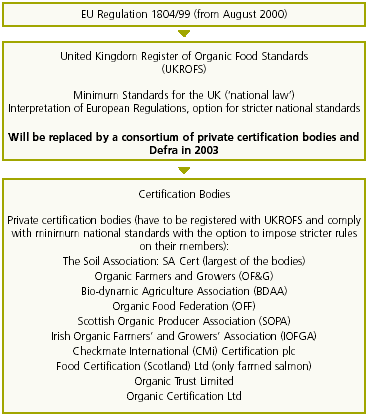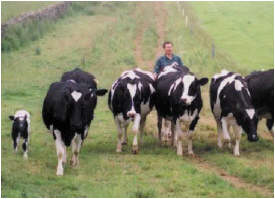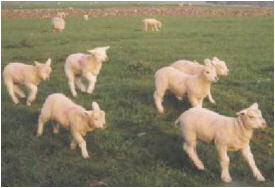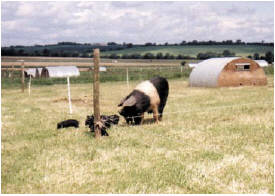



Animal Health and Welfare in Organic Livestock Production
By Malla Hovi, Veterinary Epidemiology and Economics Research Unit, University of Reading - This paper gives an overview of the organic livestock farming in the UK.
Introduction
Organic livestock production has expanded rapidly in all EU countries in the past ten years. In the UK, the number of organic livestock producers is still growing, albeit not at the rates seen in the late 1990s, and increases in subsidies for organic farming are likely to maintain this steady growth in organic livestock production in years to come (see Tables 1, 2 and 3).
What is organic farming?
Organic farming is based on closed agricultural systems and minimal use of non-renewable energy sources (e.g. artificial fertilisers). Livestock, and particularly ruminants, play an important role in maintaining the fertility of grass/clover leys. The basic principles of organic livestock production can be summarised thus:
- land-based activity (homegrown feed; manure returned to the same land that produces the feed);
- good animal health and welfare (outdoor, free-range, maximum access to pasture etc.);
- optimisation rather than maximisation of production (breeding for traits other than yield or growth rate, feeding species-specific diets etc.);
- lower stocking densities and production levels than in conventional systems (stocking densities on dairy farms on average 80% lower; on beef and sheep farms 40-80% lower).
Organic certification
Definitions of ‘organic’ farming vary internationally. Many countries operate national or ‘private’
standards, which do not have statutory status. The International Federation of Organic Farming
Movements (IFOAM) operates an accreditation scheme for private and public certification bodies in
order to bring uniformity to standards, particularly in the production of export commodities.
Currently, organic farming practice is a legally defined farm assurance standard in both the EU and
the USA.
EC Regulation 1804/99, governing organic livestock production, came into force in August 2000.
At the moment, the United Kingdom Register for Organic Food Standards (UKROFS) develops and enforces the basic standards for organic livestock production in the UK, based on the EC Regulation. Farm assurance and annual farm inspections are carried out by private organic certification bodies (Figure 1); these
bodies can develop their own standards, which may be stricter than the UKROFS standards and/or those set down in the EC Regulation.
| Table 1: Number of certified organic farmers and growers in Great Britain in June 2002 | |
| Area | Number of certified organic farmers and growers |
| England | 2,611 |
| Scotland | 694 |
| Wales | 609 |
| Northern Ireland | 135 |
| Total | 4,049 |
| (modified from www.defra.gov.uk/farm/organic/stat.htm) | |
| Table 2: Estimated farm gate value of the main UK organic commodities | ||||
| 2000/2001 | 2001/2002 | |||
| Value (£m) | % | Value (£m) | % | |
| Meat | 15.7 | 16 | 28.6 | 19 |
| Eggs | 21.7 | 22 | 21.3 | 14 |
| Dairy | 20.3 | 21 | 47.2 | 32 |
| Arable | 9.8 | 10 | 14.0 | 10 |
| Fruit and veg | 29.6 | 31 | 36.9 | 25 |
| Total | 97.1 | 100 | 148 | 100 |
| (The Soil Association, 2002, Organic food and farming report 2002. The Soil Association, Bristol, UK. Pp.55.) | ||||
Organic livestock production standards at a glance
The various certification body standards usually cover the following areas of livestock production
and husbandry: origin of stock, conversion of stock, animal health and welfare, housing and husbandry, feeding and livestock records.
Origin of stock
Whilst a closed herd/flock policy is a basic principle of organic livestock production, up to 10% of the herd/flock can be replaced annually, with a requirement that “special attention must be paid to animal health measures” (the Regulation does not define these measures in any further detail but recommends that the inspecting authority apply specific measures, such as screening tests or quarantine periods, depending on the circumstances). Animals must be born to organically managed dams if they are to be slaughtered for organic meat production.
Conversion of stock
A minimum 36-week conversion period is required for dairy cattle. A suckler cow must be managed organically for 12 weeks before calving if the calf is to be sold as organic. During the conversion
period, the stock must be fed on organically produced feed and managed to organic standards. Simultaneous conversion of land and livestock is allowed as long as a livestock conversion plan
(usually expected to include an animal health plan and a disease reduction plan) is formulated and
implemented from the beginning of the conversion period.

|
Figure 1: Organic Certification System in the UK |
Animal health and welfare
EC Regulation 1804/99 states that animal health and welfare of livestock on organic farms should be
promoted primarily by preventive measures using appropriate breeds, feeds and husbandry techniques
for the species in question, and by implementing stable social conditions for breeding animals. Prophylactic use of drugs is prohibited and restrictions are placed on the use of conventional medicines. These standards require major changes in the attitudes and practices of converting livestock
producers and call for a systems based approach to health and welfare management on the farm. Veterinary inputs in the form of antibiotics, antiparasitic drugs and vaccines are acceptable in the treatment of clinical disease or where there is a known disease risk. When prophylactic or metaphylactic inputs are used on a herd/flock basis, the prescribing veterinary surgeon is usually required to justify their use by identifying particular risk factors, and by explaining why they cannot be dealt with by husbandry/
systems changes (e.g. double fencing, evasive grazing etc.).
Prophylactic use of antibiotics on a herd/flock basis (e.g. blanket antibiotic dry cow therapy) is prohibited, as is the use of organophosphorous compounds (OPs), and avermectins other than moxidectin (which is seen as being less environmentally harmful).
The use of alternative or complementary medicines is encouraged, by a requirement to extend the
statutory withdrawal periods for milk and meat to at least double the official period and to 48 hours
where the statutory withdrawal period is nil. Only three courses of treatment with conventional veterinary medicinal inputs are allowed for an individual animal in any year before it loses its organic
status.
It is worth noting that organic standards specify that statutory disease control measures must be
adhered to on organic farms, even if this means that the stock in question lose their organic status
as a result.
Housing and husbandry
Housing and management must be appropriate to the behavioural needs of livestock. Loose housing with outdoor access and the use of bedding are the cornerstones of the standards. No more than 50% of the floor area may be slatted, and tethering is prohibited. Dehorning and castration in all stock and tail docking in sheep are accepted under the guidelines of general welfare legislation. A derogation for beak trimming in organic layer flocks has recently been accepted.

|
Figure 2: Friesian cattle on an organic dairy farm in the Peak District (courtesy of the Derby
Evening Telegraph) |
The general principle of livestock feeding in organic systems is that animals have to be fed species specific diets (e.g. dry matter of ruminant diets to contain a maximum of 40% concentrates, weaning of piglets no earlier than six weeks of age). Grazing should be maximised and mineral, trace element and vitamin supplementation is permitted when the requirement cannot be met by husbandry practices. Artificial amino acids, solvent extracted feed components and antibiotic feed enhancers are prohibited.
All livestock in organic systems should receive only organic feed; if this is not possible immediately after conversion, 10-30% of the dry matter can come from conventionally produced sources, depending on the livestock system and species; this derogation is likely to be phased out by the end of 2005, when organic farming is expected to have grown to the extent that adequate amounts of organic feed are available.
Livestock records
Organic standards require accurate and comprehensive recording on the farm. Records must be kept for all stock movements, disease events and mortalities. All veterinary and non-veterinary treatments must be recorded in detail, including statutory and ‘organic’ withdrawal periods.
How are organic livestock production systems coping with animal health and welfare?
A recent European project brought together veterinary and animal welfare researchers from 17 research institutes in 13 different countries. It concluded that, in many European countries, there is growing evidence to suggest organic farming has improved animal welfare, mainly by banning some of the most intensive livestock production practices (e.g. all types of battery cages, early weaning of piglets, tethering of ruminants etc.). The rest of this article summarises the available evidence on animal health and welfare in the different organic livestock production systems.
| Table 3: Organic meat production in the UK | ||||
| 2000/2001 | 2001/2002 | |||
| Head | Value (£m) | Head | Value (£m) | |
| Beef | 5,000 | 3.0 | 9,000 | 5.7 |
| Lamb | 39,000 | 2.1 | 109,000 | 5.5 |
| Pork | 32,000 | 3.5 | 52,000 | 6.9 |
| Poultry | 1,300,000 | 7.2 | 2,100,000 | 10.5 |
| Total | 15.8 | 28.6 | ||
| (The Soil Association, 2002, Organic food and farming report 2002. The Soil Association, Bristol, UK. Pp.55.) | ||||
Dairy production
Mastitis has often been perceived as the main animal health problem in organic dairy herds. Most surveys suggest that mastitis prevalence and incidence in organic herds are similar to those found in conventionally managed herds. However, a UK survey reported that the incidence of mastitis in organic herds was significantly lower during lactation, and higher during the dry period, than in matched conventional herds.
Available data suggest that organic dairy cows have lower milk yields than cows in comparable conventional systems. In spite of these relatively low production levels, it has been suggested that organic dairy cows with high genetic potential for milk production may be at risk from energy deficiency in early lactation and may, consequently, suffer from metabolic disorders and poor fertility. The existing data on the incidence of metabolic and digestive disorders in organic dairy cows is contradictory and does not appear to support this.
Organic housing and feeding standards (i.e. dry bedding, limited slatted floors, low stocking densities and forage-based diet) may potentially promote good foot and hoof health. Severe restrictions on the use of anthelmintic agents require major changes in husbandry in most livestock systems converting to organic production, and alternative control strategies are required to guarantee a sustainable balance between the parasites and the stock.
Beef production
While the number of organic dairy farms in the UK is currently overtaking the number of organic beef farms, organic beef suckler production is still one of the main lines of organic livestock production. While low levels of disease in extensive, conventional beef production systems are likely to be reflected in organic systems, restrictions on feed supplements and prophylactic parasite control lead to the risk of mineral deficiencies and heavy parasite burdens unless adequate husbandry and monitoring systems are put in. A study of upland organic beef suckler units in the UK reported high fertility performance in the cows, and no differences in growth performance and parasite burdens between conventionally and organically managed herds.

|
Figure 3: Lambs on a mixed organic farm in the Peak District (courtesy of Beechenhill Farm) |
Lamb mortality, lambing percentage and ewe replacement rates in organic and conventional UK systems are similar. However, restrictions on internal and external parasite control with conventional prophylactic antiparasiticides are recognised as a major constraint for organic sheep health management. In order to improve parasite control in organic sheep and beef systems, several on-going research projects in Europe in recent years have concentrated on developing alternative strategies to anthelmintic use; these include the use of nematophagous fungi, breeding for resistance against helminths, inclusion of bioactive forages in the diet, and vaccines. However, since most of these options still need major development before being implemented at farm level, organic sheep farmers still rely on grazing management procedures such as repeated moves to clean pastures.
Pig production
In the UK, outdoor breeding units have been relatively easy to convert to organic production, where farm size and crop rotations have allowed adequate space. Organic standards require access to outdoor areas for breeding herds and for a minimum of four fifths of the lives of fattening pigs. Tethering, decks and entirely slatted floors are forbidden. The minimum weaning age for piglets is 40 days and roughage must be offered daily at all stages of production. Inclusion of synthetic amino acids in pig rations is not allowed. This production framework poses some challenges, but is also likely to have beneficial impacts on the health and welfare of organically managed pigs. For instance, moving and mixing of animals derived from different farms is limited, something which could be expected to reduce pressure from infectious diseases. Also, the later weaning age in organic pig production is likely to reduce nutritional challenges in this period, as the piglets’ digestive tract is more mature than in early weaning systems. A recent UK study of organic pig production found very few health problems.

|
Figure 5: An organic broiler unit in Wiltshire |
Organic poultry production standards require free-range systems with access to the outdoors in both layer and broiler units. Maximum stocking densities, both outdoors and indoors, and minimum requirements for paddock rotations and paddock resting periods are specified. Synthetic amino acids are excluded from rations. Routine mutilations like beak trimming are prohibited and there are restrictions on in-feed medication, particularly with antibiotics.
There are indications that the incidence of helminth infections (Ascaridia galli, Heterakis gallinarum and Capillaria spp.) in laying hens is considerably higher in organic production systems than in conventional ones; however, in organic broiler production, there is little evidence to suggest that coccidiosis is a major problem, despite the ban on prophylactic use of anticoccidials. Organic poultry production will face major challenges in the near future, when the requirement to source layer pullets and day-old broiler chicks from organic breeding units comes into force. Poultry breeding and pullet rearing standards are currently being developed.
Animal welfare
Perceived animal welfare benefits have been quoted as an important aspect of consumer motivation in buying organic products. The basic principles of organic farming emphasise species-specific husbandry and freedom to express natural behaviour. However, organic standards have been criticised for poor ethical definition and poor provision of detailed animal welfare guidelines. The Farm Animal Welfare Council (FAWC) interim report on the welfare implications of farm assurance schemes suggests that organic standards are implicit rather than explicit on animal welfare issues when compared with, for example, the UK Royal Society for Prevention of Cruelty to Animals‘ Freedom Foods standards. By contrast, the preliminary results of a survey of UK vets, farm advisers and organic certification body inspectors on the potential impact of 44 organic livestock management standards derived from the EU Regulation 1804/99, found that the respondents considered the majority of standards to have a positive impact on animal welfare. However, the same survey also identified five standards which more than 35% of respondents considered to have a potentially negative effect on animal welfare, due to restrictions on the use of dietary supplements (vitamins and synthetic amino acids) and conventional veterinary medicinal inputs.
Future developments and challenges in animal health and welfare in organic livestock systems in the UK

|
Figure 4: Saddleback sow with litter on an organic breeding unit in Wiltshire |
Health planning
The 2001 UK organic livestock production standards have an explicit requirement for a health plan as an integral part of the approach to animal health and welfare. In the UK standards, ‘animal health plan’ is defined as: "…a plan drawn up by the farmer, preferably working in partnership with a veterinary surgeon
and agreed between them during and after conversion, to develop and operate an organic livestock system, which conforms to these standards. The plan must ensure the development of a pattern of health building and disease control measures appropriate to the particular circumstances of the individual farm and allow for the evolution of a farming system progressively less dependant on allopathic veterinary medicinal products".
A 2001 survey of 120 UK organic farmers indicated that 87% had a formal health plan in place, six months after the requirement had been introduced. When asked about their expectations in regard to the usefulness of the planning process, the majority of the farmers felt that health plans were a necessary part of positive health promotion. However, this positive attitude may be biased by the fact that the target group were early adopters of health planning among organic farmers; it has been suggested elsewhere that health planning has not been as successful as was expected, and the United Kingdom Register of Organic Farming Standards (UKROFS) intends to make the health planning requirement more
stringent in the future, requiring, amongst other things, more evidence-based approaches to decision-
making on conventional medicinal inputs.
Vaccine use
Whilst organic standards do not necessarily limit the use of vaccines in organic livestock, many
certification bodies have taken the view that vaccines are conventional veterinary medicinal products,
the use of which should gradually be reduced. Basic organic principles also consider inputs like vaccines to be part of an unsustainable system. Demands by certification bodies to reduce vaccine use on organic farms have recently led to suggestions that organic livestock suffer from poor animal welfare as a result of reduced vaccine use leading to outbreaks of disease. On the other hand, outbreaks of disease on organic farms are more likely to be investigated by laboratory diagnosis as organic farmers are required to submit evidence of disease on their farms in order to get permission to use certain veterinary medicinal inputs. Information on vaccine use on organic farms is scarce, but a 1996 survey reported that 44% of organic sheep farmers vaccinated their stock against clostridial diseases (although, in the absence of similar data from conventional sheep farms, it is difficult to make comparisons between the two systems).
In order to help organic livestock producers make informed decisions about vaccine use on their farms, a
Defra-funded development project is currently being carried out by the Veterinary Epidemiology and Economics Reasearch Unit (VEERU) and the Scottish Agricultural College. The project is developing
an electronic, web-based decision support tool for vaccine use for cattle and sheep, aiming to help
organic farmers and their veterinary surgeons to make decisions based on qualitative risk assessments.
Control of sheep scab
UK organic standards differ from the EU legislation in their strict approach to the use of OPs: any animal treated with OPs has to be identified with a permanent marker or tag and loses its organic
status permanently. Whilst the standards explicitly require that an animal suffering from a disease or
poor health needs to be treated with the most efficacious therapy available, the above limitation on
OPs encourages organic farmers to use pyrethroid-based dips to control or treat sheep scab. Scab mite resistance to pyrethroids and a perceived lack of other alternatives has lead to severe criticism of
organic sheep producers who have been blamed for breakdowns in scab control. Whilst it is possible that no more scab breakdowns occur on organic than on conventionally managed farms, there is a need for organic sheep producers to tackle scab with local eradication programmes where possible. Despite the current strict line on OPs, it might be sensible (and, it could be argued, within the organic principles) to allow the use of OPs in situations where a real threat to stock exists and where necessary biosecurity precautions have been taken, or in situations where efforts are made to establish local scab-free areas in collaboration with other farmers.
Source: Published by Defra - September 2003








